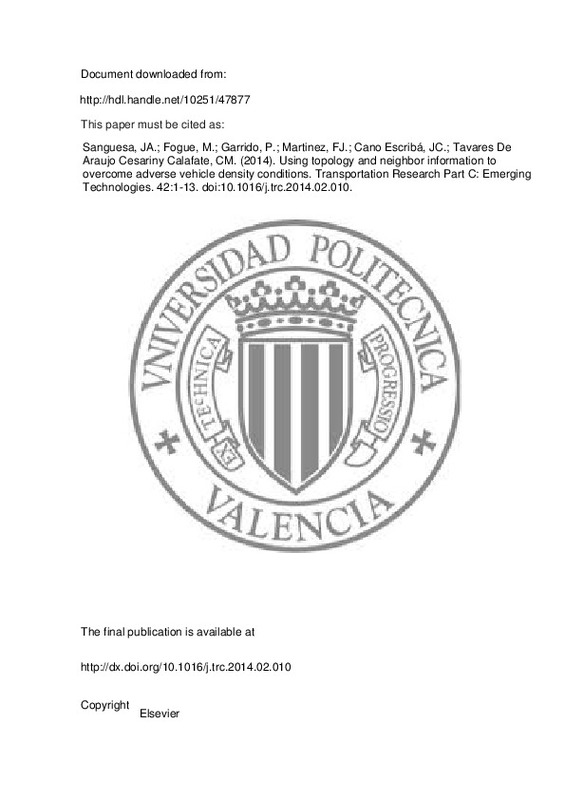JavaScript is disabled for your browser. Some features of this site may not work without it.
Buscar en RiuNet
Listar
Mi cuenta
Estadísticas
Ayuda RiuNet
Admin. UPV
Using topology and neighbor information to overcome adverse vehicle density conditions
Mostrar el registro sencillo del ítem
Ficheros en el ítem
| dc.contributor.author | Sanguesa, Julio A.
|
es_ES |
| dc.contributor.author | Fogue, Manuel
|
es_ES |
| dc.contributor.author | Garrido, Piedad
|
es_ES |
| dc.contributor.author | Martinez, Francisco J.
|
es_ES |
| dc.contributor.author | Cano Escribá, Juan Carlos
|
es_ES |
| dc.contributor.author | Tavares de Araujo Cesariny Calafate, Carlos Miguel
|
es_ES |
| dc.date.accessioned | 2015-03-09T10:44:49Z | |
| dc.date.available | 2015-03-09T10:44:49Z | |
| dc.date.issued | 2014-05 | |
| dc.identifier.issn | 0968-090X | |
| dc.identifier.uri | http://hdl.handle.net/10251/47877 | |
| dc.description.abstract | Vehicular networks supporting cooperative driving on the road have attracted much attention due to the plethora of new possibilities they offer to modern Intelligent Transportation Systems. However, research works regarding vehicular networks usually obviate assessing their proposals in scenarios including adverse vehicle densities, i.e., density values that significantly differ from the average values, despite such densities can be quite common in real urban environments (e.g. traffic jams). In this paper, we study the effect of these hostile conditions on the performance of different schemes providing warning message dissemination. The goal of these schemes is to maximize message delivery effectiveness, something difficult to achieve in adverse density scenarios. In addition, we propose the Neighbor Store and Forward (NSF) scheme, designed to be used under low density conditions, and the Nearest Junction Located (NJL) scheme, specially developed for high density conditions. Simulation results demonstrate that our proposals are able to outperform existing warning message dissemination schemes in urban environments under adverse vehicle density conditions. In particular, NSF reduces the warning notification time in low vehicle density scenarios, while increasing up to 23.3% the percentage of informed vehicles. As for high vehicle density conditions, NJL is able to inform the same percentage of vehicles than other existing approaches, while reducing the number of messages up to 46.73% | es_ES |
| dc.description.sponsorship | This work was partially supported by the Ministerio de Ciencia e Innovacion, Spain, under Grant TIN2011-27543-C03-01, by the Fundacion Universitaria Antonio Gargallo and the Obra Social de Ibercaja, under Grant 2013/B010, as well as the Government of Aragon and the European Social Fund (T91 Research Group). | en_EN |
| dc.language | Inglés | es_ES |
| dc.publisher | Elsevier | es_ES |
| dc.relation.ispartof | Transportation Research Part C: Emerging Technologies | es_ES |
| dc.rights | Reserva de todos los derechos | es_ES |
| dc.subject | Vehicular ad hoc networks | es_ES |
| dc.subject | Warning message dissemination | es_ES |
| dc.subject | Adverse density conditions | es_ES |
| dc.subject | Urban scenarios | es_ES |
| dc.subject.classification | ARQUITECTURA Y TECNOLOGIA DE COMPUTADORES | es_ES |
| dc.title | Using topology and neighbor information to overcome adverse vehicle density conditions | es_ES |
| dc.type | Artículo | es_ES |
| dc.identifier.doi | 10.1016/j.trc.2014.02.010 | |
| dc.relation.projectID | info:eu-repo/grantAgreement/MICINN//TIN2011-27543-C03-01/ES/WALKIE-TALKIE: SOPORTE A ENTORNOS DE TRANSPORTE SEGURO, INTELIGENTE Y SOSTENIBLE PARA LA FUTURA GENERACION DE COCHES INTELIGENTES/ | es_ES |
| dc.relation.projectID | info:eu-repo/grantAgreement/Fundación Bancaria Ibercaja//2013%2FB010/ | es_ES |
| dc.rights.accessRights | Abierto | es_ES |
| dc.contributor.affiliation | Universitat Politècnica de València. Departamento de Informática de Sistemas y Computadores - Departament d'Informàtica de Sistemes i Computadors | es_ES |
| dc.description.bibliographicCitation | Sanguesa, JA.; Fogue, M.; Garrido, P.; Martinez, FJ.; Cano Escribá, JC.; Tavares De Araujo Cesariny Calafate, CM. (2014). Using topology and neighbor information to overcome adverse vehicle density conditions. Transportation Research Part C: Emerging Technologies. 42:1-13. https://doi.org/10.1016/j.trc.2014.02.010 | es_ES |
| dc.description.accrualMethod | S | es_ES |
| dc.relation.publisherversion | http://dx.doi.org/10.1016/j.trc.2014.02.010 | es_ES |
| dc.description.upvformatpinicio | 1 | es_ES |
| dc.description.upvformatpfin | 13 | es_ES |
| dc.type.version | info:eu-repo/semantics/publishedVersion | es_ES |
| dc.description.volume | 42 | es_ES |
| dc.relation.senia | 279558 | |
| dc.contributor.funder | Ministerio de Ciencia e Innovación | es_ES |
| dc.contributor.funder | Fundación Bancaria Ibercaja | es_ES |
| dc.contributor.funder | Gobierno de Aragón | es_ES |
| dc.contributor.funder | Fundación Universitaria Antonio Gargallo | es_ES |
| dc.contributor.funder | European Social Fund | es_ES |







![[Cerrado]](/themes/UPV/images/candado.png)

